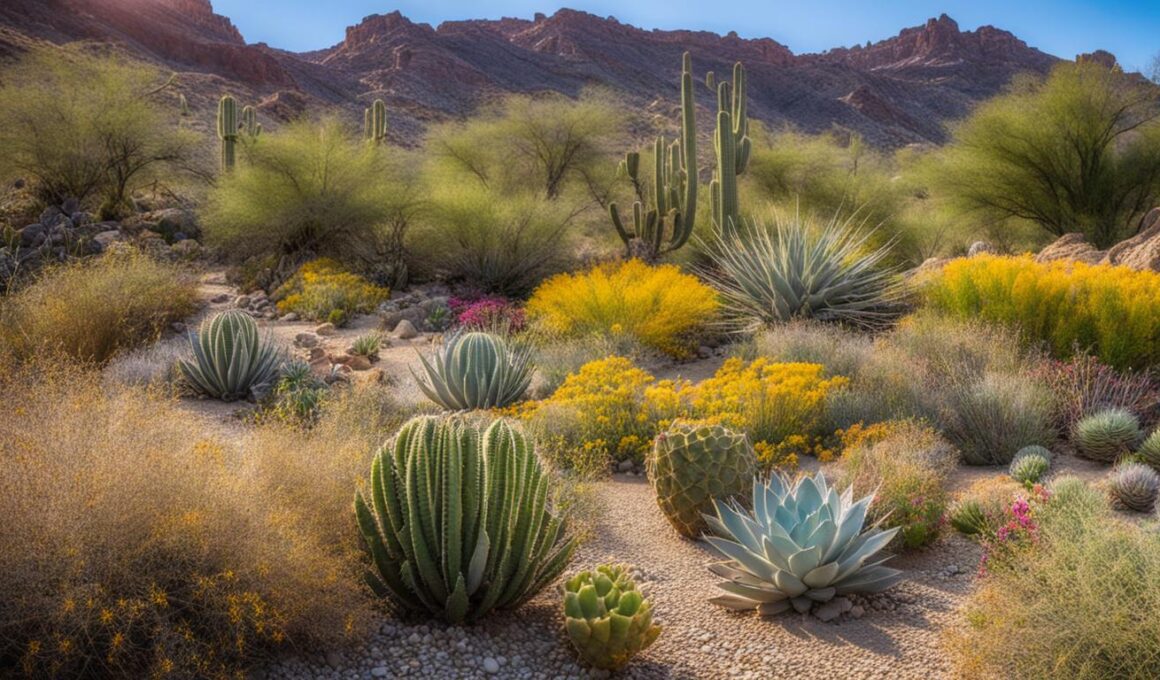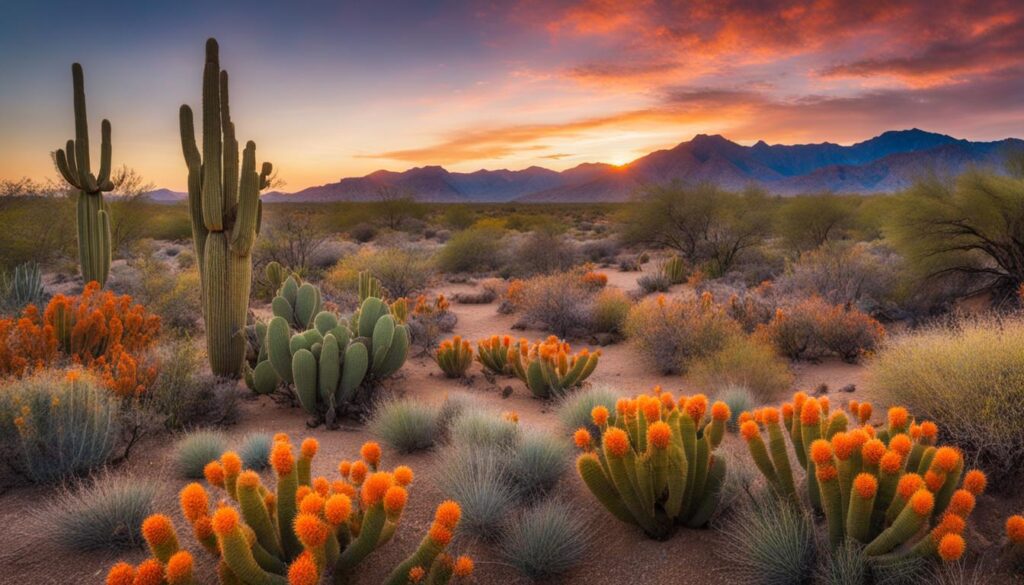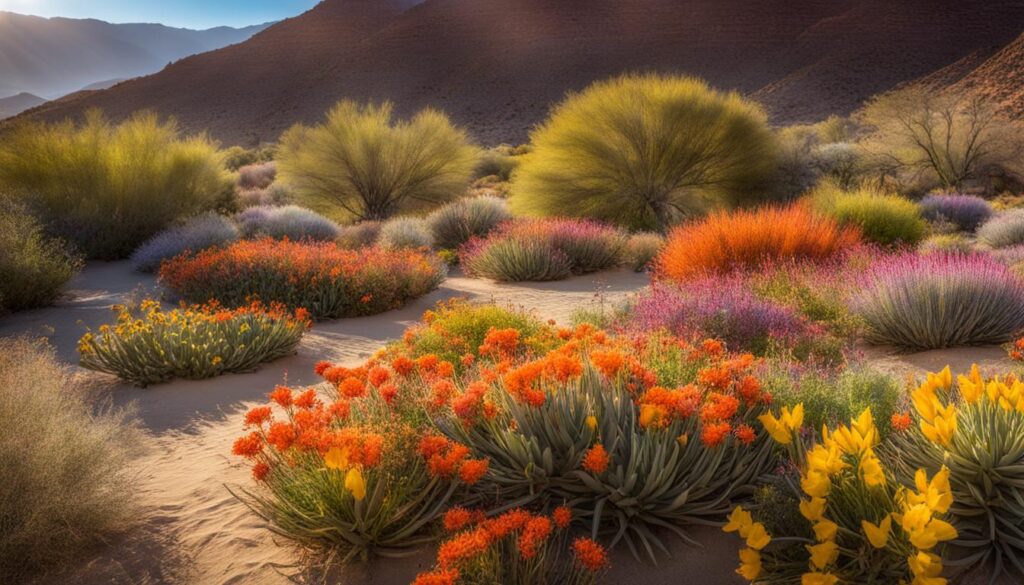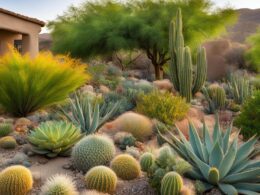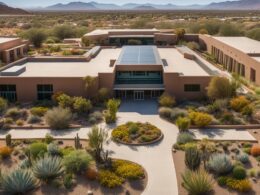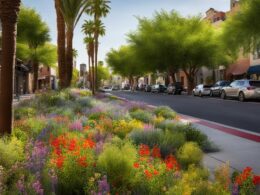Are you looking to create a sustainable garden in an arid climate? Native plant landscaping is the answer! By using plants that are native to your region, you can design a beautiful and thriving garden that requires less water and maintenance. Not only will you be conserving water, but you’ll also be supporting the local ecosystem and attracting beneficial wildlife. Let’s explore how to master native plant landscaping in arid climates and create a sustainable garden that you can enjoy for years to come.
Key Takeaways:
- Native plant landscaping is a sustainable and environmentally friendly approach to gardening in arid climates.
- By using plants that are native to the region, you can create a garden that requires less water and maintenance.
- Well-designed landscapes consider plant structure, color combinations, and bloom times to create a visually appealing space.
- Native plants are naturally balanced and resistant to the harsh conditions of arid climates.
- Fire safety is an important consideration when designing your native plant landscape in arid climates.
Simplify Your Landscape Design with Native Plants
Designing a landscape can be a daunting task, but with native plants, you can simplify the process and create a visually stunning garden that thrives in arid climates. Native plants are well-suited for these harsh conditions, requiring less water and maintenance compared to non-native species. By focusing on plant structure rather than flower color, you can easily create a landscape that complements your space.
When selecting native plants for your garden, consider their forms and shapes. Incorporating tall, vertical-growing plants at the back of your garden provides a nice backdrop, while plants with interesting leaves are perfect for shaded areas. By using a variety of plant forms, you can achieve a sense of balance and harmony in your landscape design.
Native plants also offer natural color combinations that enhance the overall aesthetics of your garden. Instead of relying solely on flower color, opt for plants with varied foliage colors. By strategically placing plants with vibrant foliage throughout your garden, you can create a visually appealing space that requires minimal effort.
“Native plants simplify the landscape design process by focusing on plant structure rather than flower color.”
Table: Native Plants for Simplified Landscape Design
| Plant Name | Main Characteristics |
|---|---|
| Agave americana | Tall and dramatic succulent with architectural appeal. |
| Yucca filamentosa | Evergreen perennial with tall flower spikes and spiky leaves. |
| Ocotillo | Thorny shrub with long, slender, and segmented stems. |
| Desert marigold | Low-growing perennial with vibrant yellow flowers. |
| Penstemon strictus | Tall perennial with showy blue-violet flowers. |
With the use of native plants, you can simplify your landscape design and create a visually appealing garden that thrives in arid climates. By considering plant structure, color combinations, and utilizing the natural beauty of native plants, you can enjoy a low-maintenance garden that adds beauty and sustainability to your outdoor space.
Choosing Native Plants for Color and Depth
While color is not the most important factor when using native plants, it can still enhance the aesthetics of your garden in arid climates. By strategically selecting native plants with vibrant colors, you can create a visually stunning landscape that adds depth and interest to your outdoor space.
Color Combinations
When choosing native plants for color, it’s essential to consider combinations that work well together. Red flowers, for example, draw attention and can be used as focal points in your garden. Pairing them with blue or purple flowers creates a striking contrast and adds depth to a small space.
Here are some native plants with vibrant colors that you can consider for your arid landscape:
| Plant | Color |
|---|---|
| Pineleaf Penstemon | Red |
| California Fuchsia | Red-orange |
| Desert Marigold | Yellow |
| Blue Flax | Blue |
| Purple Sage | Purple |
By strategically placing these native plants throughout your landscape, you can create vibrant color combinations that will make your garden truly stand out.
With strategically selected native plants and color combinations, you can transform your arid garden into a visually stunning oasis that adds depth and interest to your outdoor space.
In addition to color, the texture and form of native plants can also contribute to the overall depth of your garden. The varied leaf shapes, sizes, and arrangements can create visual interest and add depth to your landscape.
So, when selecting native plants for your arid garden, consider not only their color, but also their unique forms and textures. This way, you can create a visually appealing landscape that showcases the beauty of native plants in arid climates.
Extending the Bloom Season with Native Plants
To ensure year-round enjoyment of your garden, it is important to include native plants that bloom at different times of the year. By selecting a variety of plants with different bloom times, you can have a continuous display of flowers from spring to fall. This not only adds beauty to your garden but also provides food and habitat for pollinators and other wildlife. Consider including plants like yucca, mahonia, and evening primrose that have interesting leaves and bloom at different times throughout the year.
When planning your garden, it’s essential to choose native plants that have staggered bloom times. This will ensure that there is always something in bloom, creating a vibrant and ever-changing landscape. By incorporating early, mid, and late-blooming plants, you can enjoy a variety of colors and textures throughout the seasons.
Below is a table showcasing a selection of native plants that bloom at different times in arid climates:
| Plant | Bloom Time |
|---|---|
| Yucca | Spring |
| Mahonia | Winter |
| Evening Primrose | Summer |
| Crimson Sage | Fall |
Why Extending Bloom Time Matters
Extending the bloom season in your garden has several benefits. First and foremost, it attracts and supports pollinators such as bees, butterflies, and hummingbirds. These creatures rely on the nectar and pollen provided by flowers for their survival. By planting a diverse range of native plants with different bloom times, you can provide a continuous food source for these important pollinators.
Additionally, extending bloom time adds visual interest and variety to your garden. With a mix of early, mid, and late-blooming plants, you can enjoy a dynamic and ever-changing landscape throughout the year. This not only creates a visually stunning garden but also provides a source of joy and relaxation as you witness the beauty of nature unfolding before your eyes.
By incorporating native plants with staggered bloom times, you can create a garden that is not only visually appealing but also ecologically beneficial. The continuous availability of flowers ensures a steady supply of nectar and pollen for pollinators, supporting their populations and contributing to the overall health of your local ecosystem. So, when planning your garden, don’t forget to consider the bloom times of native plants and embrace the beauty and benefits they bring.
Fire Safety Considerations in Native Plant Landscaping
When designing a native plant landscape in arid climates, it is crucial to prioritize fire safety. By selecting the right plants and implementing appropriate measures, you can create a beautiful and safe environment. Here are some key considerations:
Choose Low-Growing Plants
Opt for low-growing native plants that have a minimal risk of igniting and spreading fire. Avoid tall grasses and needled evergreens near structures, as they can act as potential fuel sources. Instead, focus on groundcovers and shrubs that naturally stay closer to the ground.
Keep Distance from Structures
To minimize the risk of fire spreading to buildings, ensure that any needled evergreens or tall grasses are placed at least 10 feet away from any structures. This buffer zone can help prevent fire from reaching your home or other buildings on your property.
Create Defensible Space
Within a range of 10 to 30 feet from structures, establish a defensible space by removing any dead vegetation, dry brush, or other potential fire hazards. This cleared space acts as a barrier, reducing the likelihood of fire reaching your property and providing firefighters with a safe zone to defend your home if necessary.
| Plant Type | Recommended Distance from Structures |
|---|---|
| Low-growing groundcovers | Directly against foundations |
| Shrubs | 3-5 feet away |
| Trees | 20-30 feet away, depending on their size |
By following these fire safety considerations and incorporating them into your native plant landscape design, you can enjoy the beauty and benefits of a sustainable garden while protecting your property from the risks of wildfires.
Other Native Plants to Consider for Arid Landscaping
When it comes to creating a beautiful and sustainable landscape in arid climates, there are a variety of native plants that can enhance the overall aesthetic and thrive in these conditions. In addition to the plants mentioned earlier, here are a few more recommendations to consider:
Kinnikinnick
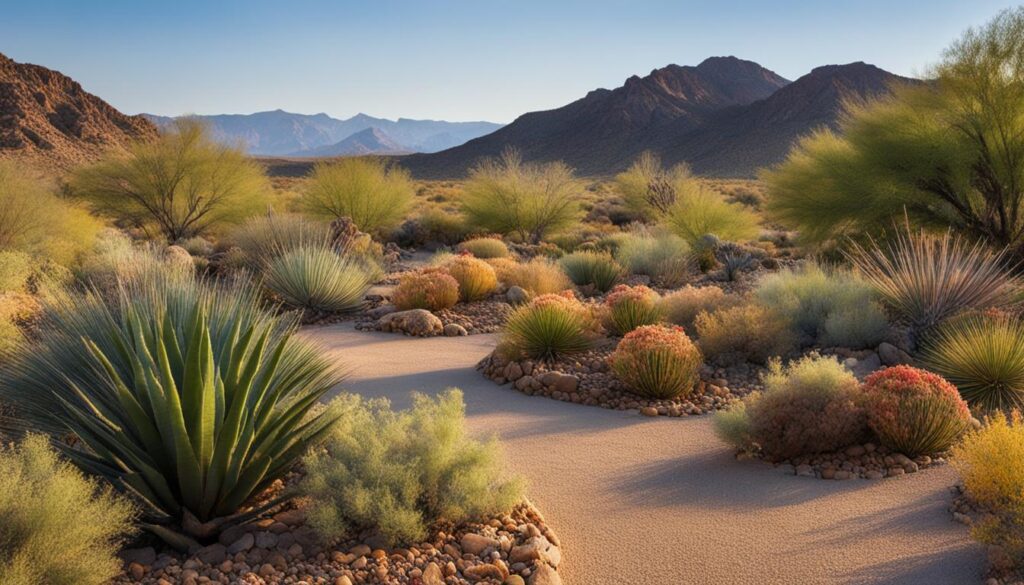
Elderberry
Elderberry is a versatile shrub or tree that not only adds visual interest to your landscape but also provides practical uses. Its large size and dense foliage make it a great option for creating visual barriers within your garden. Additionally, elderberries can be harvested and used to make delicious syrup, wine, and tinctures.
Syringa
Syringa, also known as lilac and Idaho’s state plant, is a medium to tall shrub that can add elegance to your arid landscape. With its large white fragrant flowers, it creates a beautiful focal point and attracts pollinators. Syringa is a hardy plant that can withstand the harsh conditions of arid climates.
By incorporating these native plants into your arid landscaping, you can further enhance its beauty, sustainability, and resilience. These plants are well-adapted to the local climate and require minimal water, making them an excellent choice for water-wise gardening.
Why Use Native Plants in Arid Landscaping?
Native plants are an excellent choice for arid landscaping due to their numerous benefits. Not only are they adapted to the local climate, requiring less water, but they also contribute to environmental sustainability. By using native plants in your landscape design, you can create a visually appealing garden while conserving water and supporting natural communities.
One of the main advantages of native plants is their ability to thrive in arid climates. These plants have evolved to withstand the harsh conditions, such as high temperatures and low water availability. By incorporating them into your landscaping, you can reduce the need for excessive watering, saving both time and resources. Native plants are adapted to the local soil conditions as well, minimizing the need for fertilizers and other amendments.
Another reason to use native plants in arid landscaping is their role in supporting local wildlife. Native plants provide food and habitat for birds, butterflies, bees, and other beneficial insects. By creating a diverse landscape with a variety of native plants, you can attract a wide range of wildlife species and contribute to the overall biodiversity of your area.
Additionally, using native plants in arid landscaping promotes environmental sustainability. By reducing water usage and minimizing the need for chemical inputs, you can create a more eco-friendly garden. Native plants also help prevent soil erosion and improve the overall health of the ecosystem. By choosing native plants for your arid landscaping, you are making a positive impact on the environment.
Benefits of Using Native Plants in Arid Landscaping:
- Adapted to the local climate, requiring less water and maintenance
- Create a visually appealing garden while conserving water
- Support local wildlife by providing food and habitat
- Promote environmental sustainability by reducing water usage and chemical inputs
- Prevent soil erosion and improve ecosystem health
“Using native plants in arid landscaping not only enhances the beauty of your outdoor space but also demonstrates your commitment to environmental sustainability.” – Landscaping Expert
By choosing native plants for your arid landscaping, you can enjoy a beautiful and sustainable garden that is in harmony with the natural environment. Whether you are starting a new landscaping project or looking to make changes to your existing garden, consider the many benefits that native plants have to offer.
| Benefits of Using Native Plants in Arid Landscaping | Description |
|---|---|
| Water Conservation | Native plants are adapted to arid climates, requiring less water and reducing the need for irrigation. |
| Wildlife Habitat | Native plants provide food and shelter for local wildlife, supporting biodiversity in your area. |
| Environmental Sustainability | By using native plants, you reduce the use of chemicals and promote a more eco-friendly landscape. |
| Soil Health | Native plants help prevent soil erosion and improve the overall health of the ecosystem. |
Can the Principles of Drought-Tolerant Landscaping in Arid Climates Apply to Mastering Native Plant Landscaping?
Yes, the principles of drought-tolerant landscaping can definitely be applied to mastering native plant landscaping. By understanding the various droughttolerant landscaping principles, such as selecting native plant species, proper soil management, and effective irrigation techniques, it is possible to create sustainable and thriving landscapes in arid climates.
Conclusion
Native plant landscaping in arid climates offers numerous benefits, making it an ideal choice for creating a sustainable garden. By using plants that are native to the region, you can conserve water, support local wildlife, and save on landscaping costs. With careful landscape design, color selection, and fire safety considerations, you can create a visually stunning and environmentally friendly garden.
One of the key advantages of native plant landscaping is water conservation. Native plants have adapted to thrive in arid climates, requiring less water than non-native species. This not only helps you save on water usage but also contributes to the overall sustainability of your garden. By using native plants, you can create a beautiful landscape while minimizing your environmental impact.
Another significant benefit of native plant landscaping is the creation of habitat for local wildlife. Native plants provide food and shelter for birds, butterflies, and other beneficial insects, promoting biodiversity in your garden. Furthermore, by supporting natural communities, you are contributing to the preservation of the local ecosystem and its delicate balance.
Whether you choose to design your own landscape or seek professional assistance, incorporating a variety of native plants with different bloom times ensures year-round beauty and attracts pollinators. By following the principles of native plant landscaping, you can create a visually appealing and sustainable garden that thrives in arid climates. Embrace the beauty of native plants and transform your outdoor space into a haven for both you and the environment.





